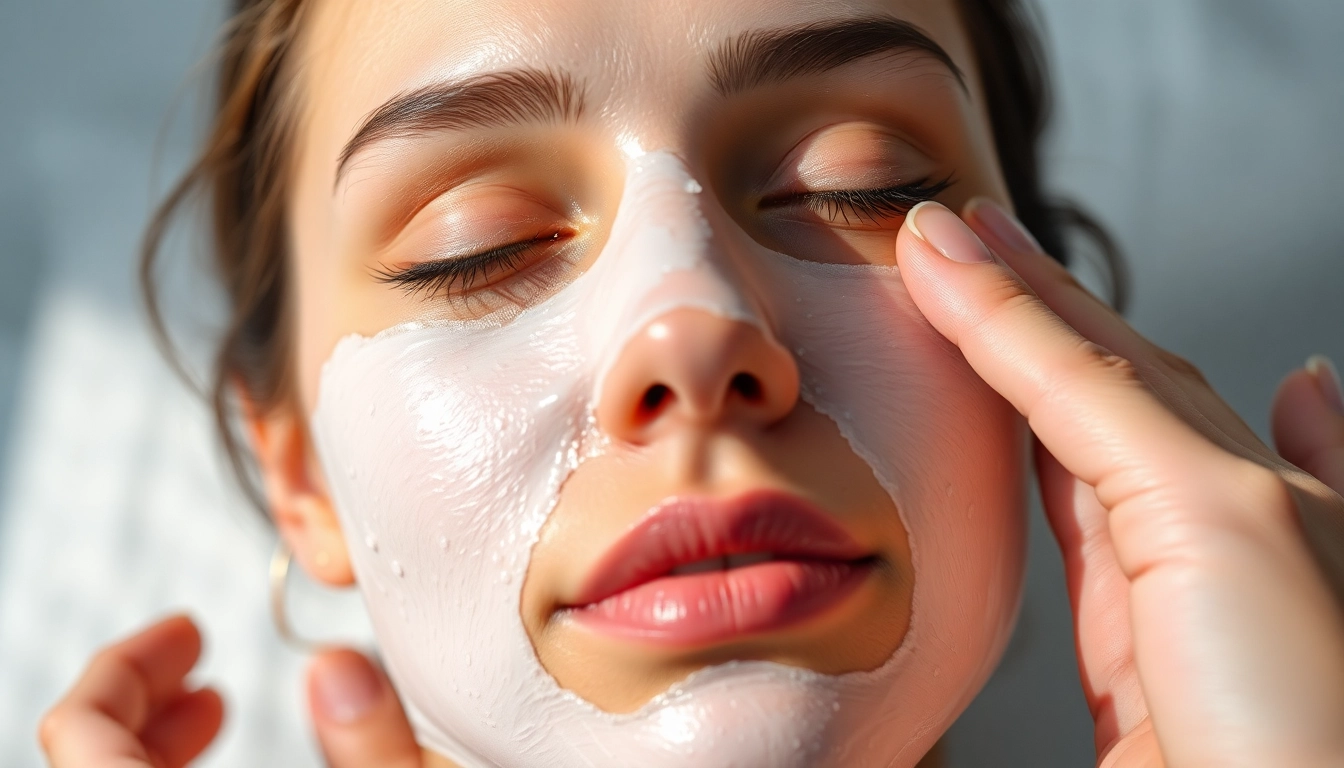Understanding Sheet Masks: A Beginner’s Guide
What is a Sheet Mask?
Sheet masks are innovative skincare products designed to deliver concentrated doses of active ingredients directly to the skin. Typically made from cotton, hydrogel, or other materials, these masks are pre-cut to fit the contours of the face, making them incredibly user-friendly. The premise behind sheet masks is straightforward: by placing a saturated mask over your face, you’re locking in moisture and beneficial ingredients, allowing them to permeate into the skin more effectively. Often soaked in serums or essences, sheet masks offer a plethora of hydration and nutrients that enhance your skin’s health and appearance. For those interested in incorporating this powerful tool into their skincare routine, consider exploring sheet mask options available at various skincare retailers.
Benefits of Using Sheet Masks
The use of sheet masks has skyrocketed in popularity, and for good reason. Here are some key benefits:
- Intense Hydration: One of the primary benefits of sheet masks is their ability to provide a substantial boost of hydration. The occlusive nature of the mask traps moisture and active ingredients against your skin, maximizing absorption.
- Convenience: Sheet masks are incredibly easy to use and require no special tools. They can be applied at home, at work, or even while traveling, making them a go-to solution for busy lifestyles.
- Instant Results: Many users notice immediate improvements in the texture and appearance of their skin after just one application. This makes sheet masks perfect for special occasions or whenever your skin needs a quick refresh.
- Variety: With an abundance of options available, from anti-aging to brightening, there’s a sheet mask for virtually every skin concern. This versatility allows users to tailor their skincare routine to their specific needs.
Types of Sheet Masks Available
Sheet masks come in various formulations, materials, and purposes. Understanding the different types helps you choose the right one for your needs:
- Cotton Sheet Masks: Made from natural cotton fibers, these masks are soft and breathable. They are generally suitable for all skin types and are often infused with hydrating serums.
- Hydrogel Masks: These masks are made from a gel-like substance, allowing for a more cooling and soothing sensation. They typically adhere closely to the skin, enhancing ingredient delivery.
- Bio-cellulose Masks: Crafted from fermented coconut juices, these masks contour perfectly to the face and offer superior bioavailability of the ingredients, resulting in more efficient absorption.
- Fabric Masks: Often made from blends of natural and synthetic fibers, these masks can deliver a variety of ingredients and effects, such as exfoliating or rejuvenating.
- Charcoal Masks: These masks are designed to detoxify the skin, drawing out impurities and excess oil while nourishing and hydrating the skin barrier.
How to Choose the Right Sheet Mask for Your Skin Type
Identifying Your Skin Type
Choosing the right sheet mask for your skin begins with understanding your skin type. Here’s how you can identify your skin type:
- Normal Skin: This skin type is characterized by a balanced moisture level. If your skin feels comfortable and neither oily nor dry, you fall under the normal category.
- Dry Skin: If your skin feels tight, flaky, or rough, it’s likely dry. People with dry skin need masks that provide intense hydration and nourishment.
- Oily Skin: If you frequently notice shine, large pores, and blackheads, your skin may be oily. Look for sheet masks with oil-absorbing properties.
- Combination Skin: Combination skin involves both oily and dry areas. Choose masks that address specific concerns while providing balanced hydration.
- Sensitive Skin: If you experience redness, itchiness, or irritation, prioritize gentle, hypoallergenic masks aimed at soothing sensitive skin.
Ingredients to Look for in Sheet Masks
Different ingredients target various skin issues. Here’s a breakdown of common ingredients to look for based on your skin concerns:
- Hyaluronic Acid: This powerhouse ingredient attracts moisture and keeps skin hydrated, making it perfect for all skin types, especially dry skin.
- Vitamin C: Known for its brightening properties, vitamin C is ideal for tackling dullness and uneven skin tone.
- Collagen: A fantastic option for mature skin, collagen-infused masks help improve elasticity and firmness.
- Aloe Vera: Renowned for its soothing capabilities, aloe vera is excellent for sensitive or irritated skin.
- Tea Tree Oil: Ideal for oily or acne-prone skin, tea tree oil can help reduce breakouts and control excess oil.
Common Mistakes to Avoid
Even with the best intentions, users can make mistakes when using sheet masks, leading to less than optimal results. Here are some pitfalls to avoid:
- Insufficient Prep: Not cleansing or exfoliating before applying a sheet mask can lead to poor absorption, limiting the mask’s effectiveness.
- Overuse: While tempting, using sheet masks too frequently can irritate the skin. It’s advisable to limit masks to 1-3 times a week based on your skin’s needs and sensitivity.
- Ignoring Ingredients: Not checking for irritating ingredients can lead to adverse effects, especially for those with sensitive skin.
- Leaving the Mask On Too Long: Many users think that leaving a mask on longer enhances results, but it can actually lead to skin dehydration. Stick to the recommended duration for optimal benefits.
Best Practices for Using Sheet Masks Effectively
Preparing Your Skin Before Application
A little preparation goes a long way when using a sheet mask. Follow these steps for optimal skin readiness:
- Cleanse: Start with a gentle cleanser to remove dirt, oil, and makeup, allowing the mask to adhere properly and maximize absorption.
- Exfoliate: For enhanced results, exfoliate your skin a couple of times a week. This removes dead skin cells and boosts the penetration of the mask’s ingredients.
- Tone: Use a toner to balance your skin’s pH and prepare it for enhanced absorption of the mask’s ingredients.
Optimal Duration for Mask Application
The time you leave a sheet mask on your face is crucial. Generally, most masks recommend an application time of 15-30 minutes. Leaving the mask on for longer than the recommended duration can result in moisture being drawn out from the skin, negating the benefits. Pay attention to the instructions on the packaging for the best results.
Aftercare: What to Do Post-Mask
After removing your sheet mask, it’s important to follow up with additional skincare steps to lock in the benefits:
- Pat, Don’t Rub: Gently pat the remaining essence into your skin rather than rubbing it, which can irritate sensitive areas.
- Moisturize: Apply a moisturizer to seal in hydration and lock the benefits of the mask. Look for a nourishing cream suited for your skin type.
- Follow Your Routine: If you have a specific skincare routine (such as serums or oils), incorporate them after the mask for added efficacy.
DIY Sheet Mask Recipes You Can Try at Home
Natural Ingredients for a Soothing Sheet Mask
Creating your own sheet masks allows for personalization to cater to your skin’s unique needs. Here are some natural ingredients that work wonders:
- Green Tea: Packed with antioxidants, it soothes the skin and reduces redness.
- Coconut Water: Hydrates and nourishes the skin, making it ideal for dry skin types.
- Honey: Known for its antibacterial properties, it’s excellent for healing and hydration.
Quick and Easy Recipes
Here are two quick DIY sheet mask recipes you can whip up at home:
- Aloe Vera & Honey Mask: Mix equal parts of fresh aloe vera gel and honey. Soak cotton pads or a sheet mask with this mixture, apply, and leave it on for 20 minutes to soothe and hydrate.
- Green Tea & Coconut Water Mask: Brew green tea and let it cool. Mix with coconut water and soak a sheet mask. Apply to your face for 30 minutes for a refreshing treatment.
Customizing Your Sheet Masks for Specific Needs
Adjusting your DIY mask to target specific concerns is straightforward. For example, add a few drops of essential oils for extra benefits, or incorporate a few crushed fruits (like banana for hydration or cucumber for cooling) to enhance your mask’s efficacy. The key is to mix and match based on what your skin craves!
Monitoring the Results: How to Evaluate Sheet Mask Effectiveness
Signs Your Skin is Responding Well
After using sheet masks regularly, assess your skin for signs of improvement:
- Increased Hydration: Noticing plumper, hydrated skin is one of the first signs that your sheet mask routine is effective.
- Decreased Dryness or Flakiness: A reduction in flaky patches signals improved moisture levels.
- Even Skin Tone: If dark spots or redness are less pronounced, your sheet masks may be working well.
Tracking Long-Term Benefits
For a comprehensive evaluation, maintain a skincare journal where you log your experiences, effects after each use, and any changes noticed over weeks or months. This can help you to understand which masks suit you best and track their benefits over time.
Combining Sheet Masks with Other Skincare Products
Sheet masks can complement your skincare routine, enhancing their overall effectiveness. Products like serums and moisturizers should be used in conjunction with sheet masks for the best results. Always allow your skin a little time to absorb each product fully before applying the next, creating a multi-layered approach to skincare that improves efficacy.



